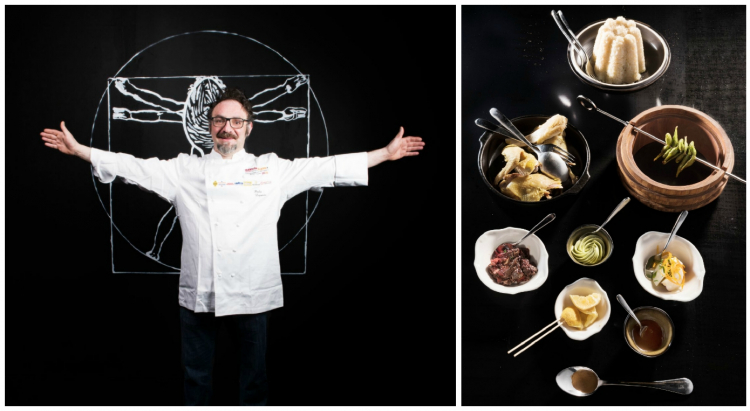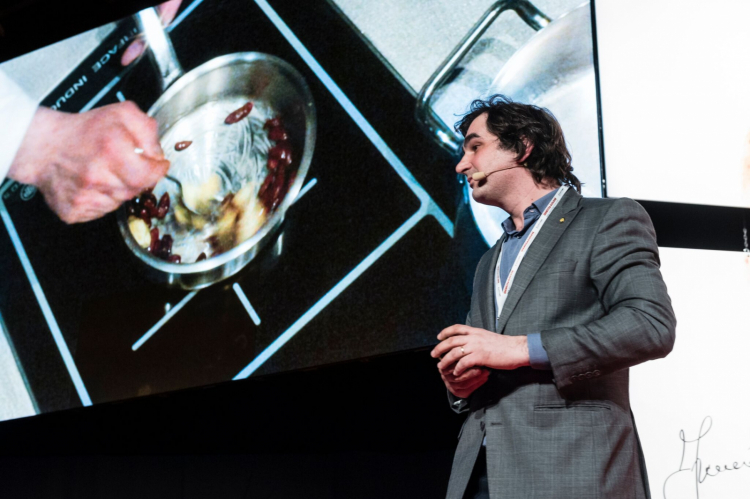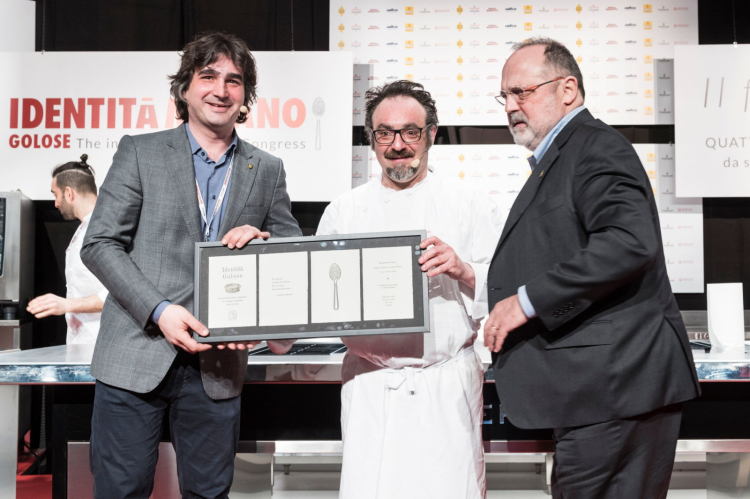«The cultural process of Italian cuisine follows two tracks: the choice of individuals, and collective choices. This is, in fact, the Human Factor. In my case, since the beginning of 2016 we’ve been discussing the interaction between three elements (kitchen – dining room – table) that involve as many actors (cook – waiter – client). The Human Factor is the relationship that grows between them.
- COOKS are attracted by raw materials. They develop their thoughts on them, and then go into the kitchen to finalise these thoughts. They then wait for a confrontation with the other actors, leading to a new, more refined elaboration that will result in ultimate perfection.
- The Human Factor also refers to CLIENTS, who feed cooks’ expectations, speak with them first, then eat and thus stimulate the cooks’ work.
- Finally, there’s WAITERS, the dining room staff, who act as intermediators between the former two. They mediate, create involvement. And by perceiving the feedback that comes from the table, they re-elaborate it thus stimulating the cook».
Paolo Lopriore
Paolo Lopriore has long been discussing dining. In his speech at
Identità Milano 2018 the cook from Como follows two parallel roads: on the one hand, the pure recipe, from which he aims to recuperate a codified ideal; on the other, the theoretical analysis of modern cuisine. There’s a connection: the latter make the conceptual foundations necessary to elaborate the former.

On the right, Lopriore’s convivial dish
- «The new frontier for creativity in a restaurant is about recuperating the homely gesture that we acquired through taste and manual skills. I present an idea of convivial dining, but in terms of creative composition. There’s bread and what goes with bread, but in a dish like the following one, there are 103 possible combinations». [In others, there can be over one thousand. This is creativity in recuperating tradition].
THE RECIPE – As usual in Lopriore’s convivial cuisine at Il Portico in Appiano Gentile, the main components of the dish, served separately (in this case rice timbale and boiled hen), are surrounded by a series of accessory ingredients. In this case: stewed beetroot, a sauce of burnt almonds, candied lemon, a reduction at cold temperature of Sichuan pepper, smoked soy, a frittata made with eggs, sweetbreads and hen’s blood with Grana Padano, butter and tarragon.
RICE TIMBALE - «I thought of rice timbale as a prosecution of what I learnt from my master,
Gualtiero Marchesi. We cook the rice in water and mix it with acid butter. This is the common Italian language that should be codified, that should emerge. This is the recipe for risotto that we should establish», standardise, «and then there’s always chefs’ creativity, who create variations». Hence: he pours white wine over the grains in the pan, and let it evaporate (
Paolo Marchi: «It’s been a long time since I last saw someone using white wine for risotto».
Paolo Lopriore: «It gives acidity and aroma. And recalls an ancient ritual». Round of applause); and adds salt right away. Then he gradually pours water, not broth. An old mould, like those used for semifreddo, is buttered two or three times, and placed in the freezer each time. After cooking the rice for 18 minutes, it is ready to be thickened with acid butter, Grana Padano and then placed in the previously buttered mould. «It’s basically a risotto alla parmigiana». Back in the fridge for a few minutes.
BOILED HEN - «Hens represent excellence in conviviality». In this case, the breed is bianca valdarnese. «I like keeping the fibre of its meat alive, but hens notoriously need a long cooking and this causes a loss in flavour and tenacity. In Italy, however, we have a gift: a creative taste. By replacing cooking water with a centrifuge juice of celery, the acid component of the latter allows for a much faster cooking (from 3-3.5 hours to 1.5 hour), so that the meat is not spoilt».
STEWED BEETROOT – Naked, sliced, immersed into melted butter and stewed. Seasoned with candied orange zest and chopped parsley.

Luca Govoni, director of the Area Storia e Cultura at Alma, the International School of Italian Cuisine in Colorno joined on the stage of the Auditorium Lopriore
- «Part of my work is recuperating Italy’s main sauces, that is to say those
intingoli that give a fatty element to the dishes». In this case, he toasts the almonds at 180°C for 20 minutes, adds butter and then blends them so as to make the sauce, a sort of fond made with almonds.
CANDIED LEMON – As with the previous accessory ingredient, it’s an emblem of Mediterranean cuisine. They keep the lemons under running water for half a day, then in boiling water, then covered in salt for 40 days in a fresh room. They rinse the lemons, cut the zest which is served into pieces. «It’s based on a technique the Berbers used to preserve food».
COLD TEMPERATURE REDUCTION OF SICHUAN PEPPER - «I’m working on the concept of liquid spices, which offer a more uniform seasoning, and hence better harmony. Spices are fresh and enveloping». He leaves the pepper to soak in cold water, and then processes in a Green Star, a slow centrifuge juicer.
SMOKED SOY - «It’s similar to the edamame you have in many Chinese restaurants. I cook the soy pods in a pot with oil, salt, barat, and then smoke them in a table smoker with beech shavings. It’s a taste accelerator. Mediterranean lemon and almonds, Sichuan pepper, now Israeli barat: it’s like retracing the Silk Way».
FRITTATA WITH EGGS, ENTRAILS AND HEN’S BLOOD, AND GRANA PADANO - «We open the eggs, season them with hen entrails (liver, stomach, heart), and salt and butter. Eggs and blood coagulate almost at the same time».
BUTTER AND TARRAGON - «I’m moving more and more towards northern Italy, hence to butter. This one, with tarragon, is inspired by the concept of butter
alla maître d’hotel, but I use heat. This is to set the chlorophyll. I fry the butter with tarragon and some shallot, then process it in the Green Star, whisk it with ice thus adding oxygen, which will further enhance the aroma».

Luca Govoni, Paolo Lopriore, Paolo Marchi
Matter inspires creativity, ingredients offer sensuality and inspiration.
Matter is creative, not man. Matter has its journey (life-death). So what happens is that man resizes nature and other things so as to understand them, rather than to find inspiration, to make current and contextualise.
Because matter was here before. It’s the energy of life and death. Matter is creative.
Paolo Lopriore
(Translated into English by Slawka G. Scarso)